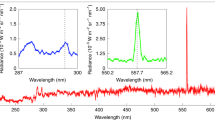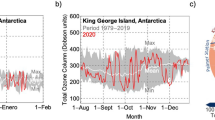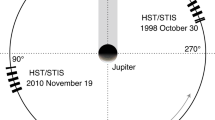Abstract
DURING the early part of this year, the nocturnal atmospheric emission in the near infra-red (to 15 microns) has been observed at College, Alaska, using a standard Perkin–Elmer single-pass monochromator with a rock-salt prism and thermocouple detector. The instrument was directed toward the southern sky, at about 20° above the horizon, giving an optical path of about four air masses.
This is a preview of subscription content, access via your institution
Access options
Subscribe to this journal
Receive 51 print issues and online access
$199.00 per year
only $3.90 per issue
Buy this article
- Purchase on Springer Link
- Instant access to full article PDF
Prices may be subject to local taxes which are calculated during checkout
Similar content being viewed by others
References
Harang, L., “The Aurorae” (Wiley and Sons, New York, 1951); Störmer, C., “The Polar Aurora” (Oxford, 1955).
Van Allen, J. A., “Scientific Uses of Earth Satellites” (Univ. of Michigan Press, Ann Arbor, 1956).
Author information
Authors and Affiliations
Rights and permissions
About this article
Cite this article
MURCRAY, W. A Possible Auroral Enhancement of Infra-red Radiation emitted by Atmospheric Ozone. Nature 180, 139–140 (1957). https://doi.org/10.1038/180139a0
Issue Date:
DOI: https://doi.org/10.1038/180139a0
Comments
By submitting a comment you agree to abide by our Terms and Community Guidelines. If you find something abusive or that does not comply with our terms or guidelines please flag it as inappropriate.



